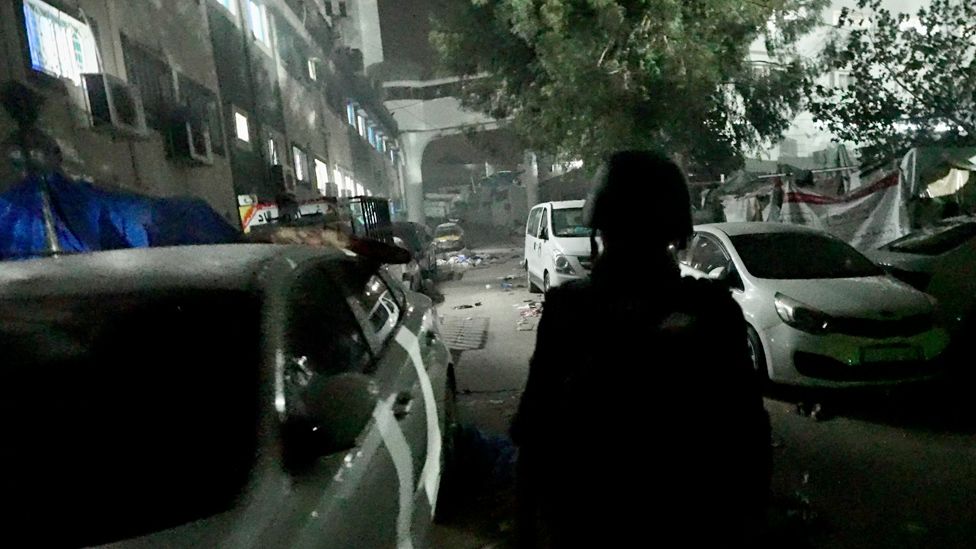1 hour ago
About sharing
We clamber into the Al-Shifa Hospital complex in darkness over a caved-in wall in the perimeter – knocked through with an armoured bulldozer on Tuesday to allow safer access for Israeli forces.
The BBC and one other television crew were the first journalists invited by the Israel Defense Forces (IDF) to view what Israel says it has found at the site.
Any extra light here is risky so we grope our way through the compound, following the heavily armed troops sent to escort us – stepping around makeshift tents, debris and sleeping people.
Doctors at the hospital say they have been working without power, food or water for days now – and that critically ill patients have died as a result, including newborn babies. People displaced by the fighting in Gaza have been sheltering in the hospital complex.
But Israel says Hamas also runs a network of underground tunnels, including under Al-Shifa Hospital.
The masked special forces leading us into the building over debris and broken glass are a sign of how tense the situation still is here. Our presence, just a day after Israel took control of the hospital, speaks volumes about Israel’s motivation to show the world why they are here.
In the brightly lit corridors of the MRI unit, Lieutenant Colonel Jonathan Conricus shows us three small stashes of Kalashnikovs, ammunition and bullet-proof vests – he says they have found around 15 guns in all, along with some grenades.
Lt Col Conricus also shows us some military booklets and pamphlets, and a map that he says is marked with potential entry and exit routes from the hospital.
What it tells us, he says, is that Hamas uses hospitals for military purposes. “[And] we uncovered a lot of computers and other equipment which could really shed light on the current situation, hopefully regarding hostages as well.”
The laptops, he says, contain photos and videos of hostages, taken after their kidnap to Gaza. There is also recently released footage, shared by Israeli police, of their interrogations of Hamas fighters arrested after the October attacks. The BBC was not shown what was on the laptops.
This, Lt Col Conricus said, suggested Hamas were here “within the last few days”.
“At the end of the day, this is just the tip of the iceberg,” he said. “Hamas aren’t here because they saw we were coming. This is probably what they were forced to leave behind. Our assessment is that there’s much more.”
Israel’s army has spent weeks fighting its way to the gates of the hospital. The streets around have seen some of the fiercest fighting in Gaza in the past few days.
Our visit was tightly controlled; we had very limited time on the ground and were not able to speak to doctors or patients there.
Our journey in to Gaza, in an armoured personnel carrier sealed tight from the darkness outside, traced the path of Israel’s first major ground incursions into Gaza weeks ago.
On the screens inside the military vehicle, the agricultural land morphed slowly into distorted streets strewn with large pieces of debris, and the blurred outlines of shattered buildings.
Just south of Gaza City, we stopped to change vehicles, clambering out on to undulating mounds of twisted metal and large chunks of rubble and concrete.
Small groups of soldiers crouched over tiny campfires, cooking a makeshift dinner beside the rows of tanks. “It’s a secret recipe,” one winked.
Above them, buildings had collapsed in strange shapes. The rolling metal door of a shopfront hung cramped, halfway open.
A Star of David was scrawled on a wall in red spray-paint; inside it someone had written “IDF”, and above it, the words: “Never Again”.
The attacks of 7 October changed the calculation for Israel in its conflict with Hamas. It has vowed to end years of uneasy standoff, by destroying both the military and political power of Hamas, designated a terrorist organisation by the UK, US and others.
That means going into the heart of Gaza City, including inside Al-Shifa.
Israeli forces are still searching for the tunnels beneath the hospital that they believe Hamas fighters may have withdrawn to, perhaps with some of the hostages.
This building has become a central focus of Israel’s war, described as a key command centre, even potentially the “beating heart” of Hamas operations.
It has taken weeks for troops to fight their way to the hospital, in the heart of Gaza City. And in the brutal information war that tails this conflict, this is Israel’s moment of truth.
After almost 24 hours securing and searching the hospital, Israel says it has found weapons and other equipment that could help provide information on both Hamas fighters and the hostages. But it has its hands on neither.
We leave the hospital, and rumble down the wide avenue that leads to Gaza’s coastal road. Gaza City is now ruled by tanks. The ghostly avenues look in places like an earthquake zone, the destruction is so severe.
It is clear what it took for Israel to get control of these streets.
More on Israel-Gaza war
Follow live: Latest updates
From Gaza: Giving birth with no painkillers under the bombs in Gaza
From Israel: Hostages’ fates haunt Israel as Gaza war intensifies
Explained: The faces of hostages taken from Israel
History behind the story: The Israel-Palestinian conflict
